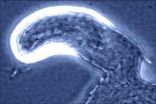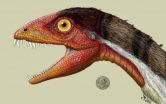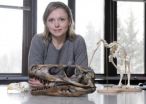(Press-News.org) Persons who have tested positive for herpes simplex virus type 2 (HSV-2) but do not have symptoms or genital lesions still experience virus shedding during subclinical (without clinical manifestations) episodes, suggesting a high risk of transmission from persons with unrecognized HSV-2 infection, according to a study in the April 13 issue of JAMA, a theme issue on infectious disease and immunology.
Anna Wald, M.D., M.P.H., of the University of Washington and Fred Hutchinson Cancer Research Center, Seattle, presented the findings of the study at a JAMA media briefing at the National Press Club in Washington, D.C.
"Herpes simplex virus type 2 is one of the most frequent sexually transmitted infections worldwide, with global estimates of 536 million infected persons and an annual incidence of 23.6 million cases among persons aged 15 to 49 years. In the United States, 16 percent of adults are HSV-2 seropositive, but only 10 percent to 25 percent of persons with HSV-2 infection have recognized genital herpes. Moreover, most HSV-2 infections are acquired from persons without a clinical history of genital herpes," according to background information in the article. Thus, the risk of sexual transmission does not correlate with the recognition of clinical signs and symptoms of HSV-2 but most likely correlates with the activity of the virus on the genital skin or mucosa (viral shedding).
Dr. Wald and colleagues compared the rates and patterns of genital HSV shedding in 498 immunocompetent HSV-2-seropositive persons between March 1992 and April 2008. Each participant obtained daily self-collected swabs of genital secretions for at least 30 days. The rate of viral shedding (the presence of virus that is actively replicating, and can thereby be transmitted to another person) was measured by polymerase chain reaction (testing method for viral DNA) from the swabs.
Among the findings of the researchers, HSV-2 was detected on 4,753 of 23,683 days (20.1 percent) in 410 persons with symptomatic genital HSV-2 infection compared with 519 of 5,070 days (10.2 percent) in 88 persons with asymptomatic infection. Genital HSV was detected at least once in 342 of 410 persons (83.4 percent) with symptomatic HSV-2 infection and in 60 of 88 (68.2 percent) persons with asymptomatic HSV-2 infection during the 2 month study.
Subclinical genital shedding rates were higher in persons with symptomatic infection compared with asymptomatic infection (2,708 of 20,735 [13.1 percent] vs. 434 of 4,929 [8.8 percent]). "However, the median [midpoint] amount of HSV detected during subclinical genital shedding episodes was similar in persons with symptomatic and asymptomatic infection," the authors write.
Persons with symptomatic infection had more frequent genital shedding episodes compared with persons with asymptomatic infection (median 17.9 vs. 12.5 episodes per year). Days with lesions accounted for 2,045 of 4,753 days (43.0 percent) with genital viral shedding among persons with symptomatic genital HSV-2 infection compared with 85 of 519 days (16.4 percent) among persons with asymptomatic infection. This indicates that the bulk of days of shedding in persons with asymptomatic HSV-2 is unrecognized, and people may engage in sexual activity not knowing that they are at risk for transmitting the virus to sexual partners.
"Our findings suggest that 'best practices' management of HSV-2-infected persons who learn that they are infected from serologic testing should include anticipatory guidance with regard to genital symptoms, as well as counseling about the potential for transmission. The issue of infectivity is both a patient management and a public health concern. The primary concern of many HSV-2-seropositive persons is the risk of transmission to sexual partners; in our experience this is the main source of angst in patients with genital herpes."
The researchers note that several methods have been identified that partly reduce the risk of HSV-2 transmission to sexual partners. "Condom use, daily valacyclovir therapy, and disclosure of HSV-2 serostatus each approximately halve the risk of HSV-2 transmission. However, these approaches reach a small portion of the population and have not had an influence on HSV-2 seroprevalence in the last decade. One of the reasons for such a limited effect is that few people are aware of their genital HSV-2 infection, and routine serologic testing, although available commercially, is recommended only in limited settings. We hope that these data will result in further discussions regarding control programs for HSV-2 in the United States."
###
(JAMA. 2011;305[14]1441-1449. Available pre-embargo to the media at www.jamamedia.org)
Editor's Note: Please see the article for additional information, including other authors, author contributions and affiliations, financial disclosures, funding and support, etc.
Please Note: For this study, there will be multimedia content available, including the JAMA Report video, embedded and downloadable video, audio files, text, documents, and related links. This content will be available at 10 a.m. ET Tuesday, April 12 at this link.
To contact Anna Wald, M.D., M.P.H., call Susan Gregg at 206-616-6730 or email sghanson@uw.edu.
END
There are differences between adult and pediatric patients regarding the appropriate treatment and prevention efforts for health-care associated infections, highlighting a need for pediatric-specific quality measures to guide infection prevention and treatment practices, according to a commentary in the April 13 issue of JAMA, a theme issue on infectious disease and immunology.
Camille Sabella, M.D., of the Cleveland Clinic Children's Hospital, presented the commentary at a JAMA media briefing at the National Press Club in Washington, D.C.
Dr. Sabella and commentary ...
In a callous political move, Governor Cuomo dealt a significant blow to the rights of brain damaged children to help offset the State's budget shortfall. Shortly after this election, the Governor appointed a Committee to review medical malpractice cases. The committee consisted of medical-hospital-insurance representatives. There was no one to speak for neurologically impaired infants. The Committee recommended and the Governor pushed the Legislature to pass, and he immediately signed, a bill establishing a "Neurologically Impaired Infant Medical Indemnity Fund".
As ...
Bacterial genes that make urine less acidic could be good targets to prevent catheter blockage, according to research presented at the Society for General Microbiology's Spring Conference in Harrogate. The findings could lead to new strategies to prevent serious infections, particularly in long-term catheterization patients.
Urinary catheters are devices used in hospitals and community care homes to manage a range of bladder conditions, and are commonly used to manage incontinence in elderly individuals for long periods of time. Scientists from the University of Brighton, ...
Manuka honey could be an efficient way to clear chronically infected wounds and could even help reverse bacterial resistance to antibiotics, according to research presented at the Society for General Microbiology's Spring Conference in Harrogate.
Professor Rose Cooper from the University of Wales Institute Cardiff is looking at how manuka honey interacts with three types of bacteria that commonly infest wounds: Pseudomonas aeruginosa, Group A Streptococci and Meticillin-resistant Staphylococcus aureus (MRSA). Her group has found that honey can interfere with the growth ...
ANN ARBOR, Mich. — Researchers at the University of Michigan Health System have uncovered a new link between genetic variations associated with alcoholism, impulsive behavior and a region of the brain involved in craving and anxiety.
The results, published online April 12 in Molecular Psychiatry, suggest that variations in the GABRA2 gene contribute to the risk of alcoholism by influencing impulsive behaviors, at least in part through a portion of the cerebral cortex known as the insula, says study senior author Margit Burmeister, Ph.D., research professor at U-M's Molecular ...
On the off chance that any of my Wealth Counsel colleagues from warmer climes are unaware of conditions in the Midwest, southeast Michigan in mid-February is not full of sun and ripe for delightful outdoor activities (I've shocked you, I'm sure). Some people from our wonderful state enjoy all that our winters have to offer, including skiing, snowboarding and snowmobiling. Our law practice, however, has a significant number of retirement-age clients, and for those clients, and for the rest of us who prefer to reserve our outdoor recreation for the warmer months, February ...
EDITOR'S PICK
Protein could improve recovery from heart attacks
Angiogenesis, the development of new blood vessels, is required during embryonic development and wound healing, as well as during disease processes such as tumor growth. The signals that direct angiogensis are incompletely understood, but could represent novel targets for the development of therapies that promote or inhibit this process.
In this paper, Young-Guen Kwon and colleagues, of Yonsei University in Seoul, Korea, investigated the role of two related proteins- DKK1 and DKK2- in angiogenesis. These ...
A team of scientists led by the Smithsonian Institution has discovered a fossilized dinosaur skull and neck vertebrae that not only reveal a new species, but also an evolutionary link between two groups of dinosaurs. The new species, Daemonosaurus chauliodus, was discovered at Ghost Ranch, N.M. The team's findings are published in the Proceedings of the Royal Society B, Wednesday, April 13.
The oldest known dinosaurs walked or ran on their hind legs and included early predatory species such as Herrerasaurus. They existed in what are now Argentina and Brazil early in the ...
This press release is available in French.
Pigeons may not instill the same aura of fear as a Tyrannosaurus rex, but they inherited their sense of smell from such prehistoric killers.
Birds are known more for their flying abilities and their senses of vision and balance than for their sense of smell. According to conventional wisdom, the sense of smell declined during the transition from dinosaurs to birds as the senses of vision and balance were improved for flight. But new research published today by scientists at the University of Calgary, the Royal Tyrrell Museum ...
A simple dictionary search for the word mediation reveals the following definition: action in mediating between parties, as to effect an agreement or reconciliation. Legal practitioners are familiar with mediation as an alternative dispute resolution technique that utilizes a neutral party, the mediator, to assist two or more parties in coming to an out-of-court resolution to a dispute. Mediation is a common and effective technique that has long been used in general civil disputes, as well as in divorce and child custody matters. In fact, I first trained as a domestic relations ...


